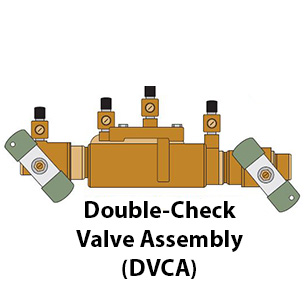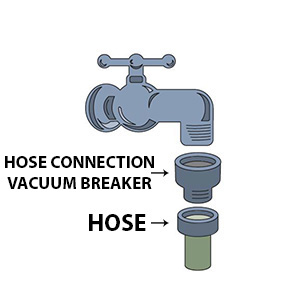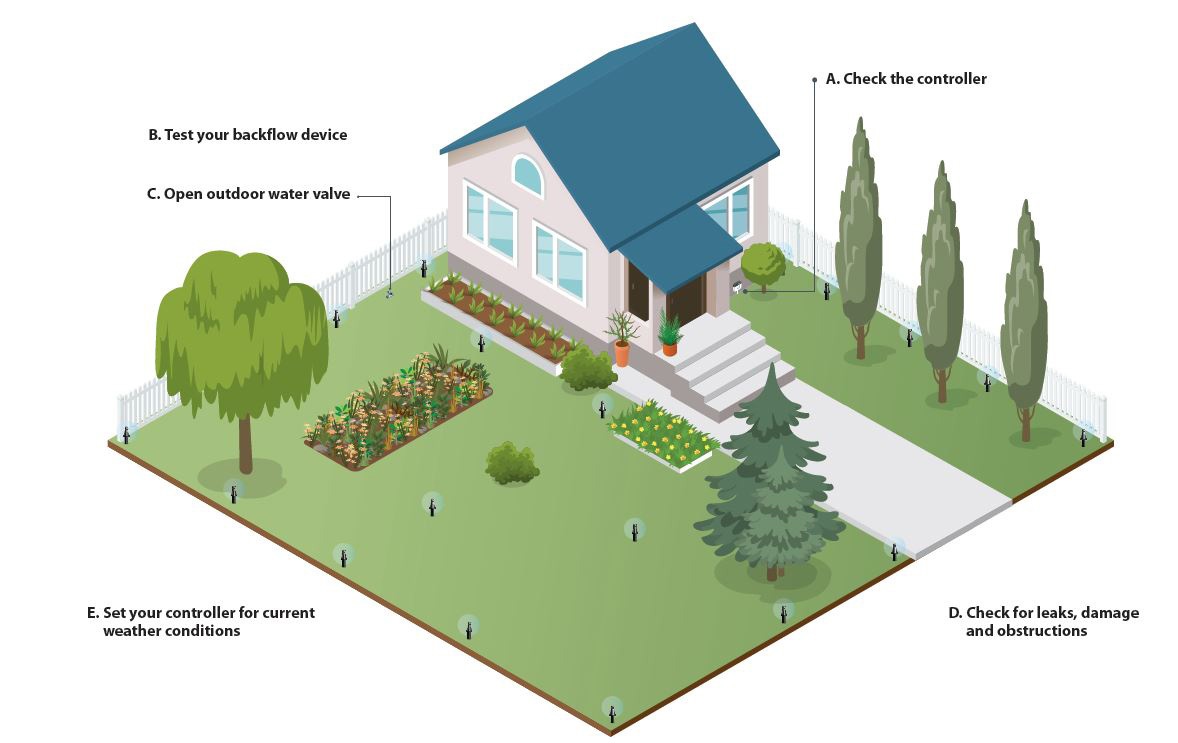Irrigation setup and maintenance tips
Irrigating a landscape is a method of providing water to plants that they need to survive drought conditions and thrive.
Knowing how much water to use and when is important to achieve the right balance between keeping your water use low and keeping a healthy, resilient landscape.
Different methods are available to irrigate your landscape, and you need to be sure that you choose the most efficient and cost effective method for your property.
Types for irrigation
Manual irrigation
Manual irrigation is done using a garden hose attached to a sprinkler, watering wand or spray nozzle.
While this method can be more water efficient and cost less than an automatic irrigation system, it can be time intensive – especially if you have a large property.
For more information on watering, see our Watering 101 tips:
Automatic irrigation
An automatic irrigation system is a series of pipes and water distribution devices located on the soil surface or just below ground that is connected to a water supply and is operated by an automatic controller.
Automatic irrigation includes surface spray irrigation in which sprinkler heads and rotors are used on turf areas, and drip irrigation which is a network of small tubes irrigating the root zone of plants.
Automatic irrigation systems can be an easy, effective way to water your landscape - provided the system is properly installed and maintained. If not properly installed and maintained, this method can be less water efficient and cost more to operate.
Since we pay for all the water we use in our homes, including outdoors, homeowners should make sure the system they use is properly cared for during the summer.
Maintaining your irrigation system
Automatic irrigation systems need regular maintenance to keep them working efficiently and effectively each year.
Maintaining your irrigation system will reduce wasted water and overwatering. It will also improve plant health, keeping your yard healthy and beautiful.
Wasted water costs more money and can result in the shortening of your plants’ root systems (trees, shrubs and grasses) making them less resilient to dry conditions.
Automatic irrigation systems can be complex – we recommend you hire a certified irrigation professional to ensure system maintenance is done correctly. To find local, certified professionals, visit cpcia.ca
Start fresh in the spring
Click picture for a full size image.
A. Turn on your timer/controller before operating the system for the first time. Check the battery and wiring for any loose connections.
B. Test your backflow device each year. This must be done by a certified cross connection tester.
C. Open your outdoor water valve located in either the mechanical room, furnace room or outside, as well as your master valve for the irrigation system.
D. Check for leaks or damage to the system and have them repaired by a professional.
E. Make sure the controller is scheduled for the current weather conditions. Check your controller instruction manual to ensure you are making the right schedule modifications for your equipment.
E. (continued) Consider using a ‘cycle and soak’ schedule to allow for maximum water absorption and minimum run off. Instead of running the system for one long time, set up the controller to operate the system at two shorter start times (cycle), with a 30 minute break (soak) between.
E. (continued) This allows the water to penetrate deeper into the root zone of the plant, creating stronger, healthier grass, that doesn’t need to be watered as often, and reduces runoff created by applying too much water at a single time.
Inspect your system monthly
Look for leaks, broken or clogged sprinkler heads and any other problems that can occur while the system is in use.
Check your controller and change the schedule to reflect the needs of the landscape as the weather changes throughout the season.
If you adapt your watering schedule to the season and weather conditions, you will see water savings during times when watering is not needed.
Winterize your system in the fall
Turn off your outdoor water supply and controller, and ensure lines and low spots are empty of water.
Book a sprinkler winterization with your certified irrigation professional.
Cross connection devices
All homeowners must do their part to protect our drinking water supply. All automatic irrigation systems must be protected from backflow by installing approved cross connection control devices.
When starting up your automatic irrigation system each spring, get your cross connection control device tested by a certified cross connection tester.
To learn more, visit the Cross Connection Control Program.
Knowing your system
Automatic controller is a timing device that sends an electric signal to valves, telling them when to open and close as per a set irrigation schedule.
Smart Controller is an irrigation control system that uses weather-based calculations and environmental conditions to determine how much water to apply to a landscape based on plant water needs.
Cross Connection Control Device is a mechanical device that stops the backflow of water into public drinking water, preventing contamination of the water supply.
For in-ground irrigation systems, Double-Check Valve Assembly (DCVA) are required. For manual irrigation with a hose attached to your outdoor water supply, use a Hose Connection Vacuum Breaker (HCVB).


To learn more, visit the Cross Connection Control Program.
Surface spray irrigation refers to an irrigation system that distributes water through the air over a large area, such as turf, using spray or rotor sprinklers.
Drip irrigation refers to any irrigation system that applies water directly to the root zone very slowly. This technology is the most efficient for water and energy use.
Master valve is the main valve for the irrigation system. When this valve is closed water will not be supplied to the irrigation system.
Hose Timer is a device that attaches to your outdoor faucet and automates manual watering.
How to check if your system is working
- Place several small containers evenly between each of your sprinkler heads (tuna cans and frisbees work well).
- Turn the sprinklers on for 10 minutes.
- Measure the amount of water in each container. Differences in the amount of water in each container shows uneven water distribution over the test area.
- Make the required adjustments or repairs to your sprinkler heads or contact a certified irrigation professional to make repairs.
Finding leaks in your system
Automatic irrigation system leaks can occur as a result of improper system installation, damage from construction, changes in weather (freeze and thaw), and improper, or lack of winterization and maintenance.
Leaks should be identified and repaired as quickly as possible because they can add up quickly on your monthly water bill. A break in an underground irrigation line can waste up to 1200 m3 in a month.
| Residential water and wastewater rates | 2023 $/m3 | 2024 $/m3 | 2025 $/m3 |
|---|---|---|---|
| Water | 1.42 | 1.46 | 1.60 |
| Wastewater | 1.62 | 1.69 | 1.80 |
| Sum | 3.04 | 3.15 | 3.40 |
Look for indications of a leak. Look for an unexplained increase in your water bill, poor system performance, dry spots, soggy spots, overgrown areas of turf or an unexplained hissing sound.
Inspect the system for broken or clogged sprinklers and other damaged components.
Contact your certified irrigation professional to help identify and repair leaks and to ensure that your system is operating properly.
Track your water use. Compare your average monthly water use over the winter months, to the months you are using water outdoors in the summer.
The difference between summer and winter consumption is the volume of water that you are using outdoors.
To compare to the previous year, look at past bills, or at the historical water use graph at the top of your water bill to get a year-over-year comparison.
How to irrigate efficiently
Wipe out overwatering
Look for signs that your lawn is being overwatered: water is puddling, soil is soft and mushy, mushrooms appear and the lawn can have a musty smell.
Grass benefits from deep watering less often. Soak the root zone and then let the soil dry completely. This creates deeper roots, allowing the lawn to be healthier and more tolerant of dry conditions.
Adapt your watering schedule for the weather and the season
If you have an automatic system, familiarize yourself with the settings on the irrigation controller and adjust the watering schedule regularly.
During cooler periods, typically in the spring and fall, reduce the frequency of watering, and allow the soil to dry completely between watering.
If you are irrigating manually, take note of the weather and make sure you are not watering if it has rained in the last few days.
If you have an in-ground system, familiarize yourself with the settings on the irrigation controller and adjust the watering schedule regularly.
Adjusting your watering schedule to reflect current conditions keeps plants healthy and resilient without overwatering.
Water early in the morning between 3 a.m. to 7 a.m.
This will reduce water lost to evaporation during the heat of the day and when there is more wind.
Check sprinklers and sprinkler heads for maximum efficiency
Always make sure that manual sprinklers and sprinkler heads (with automatic irrigation systems) are watering the landscape and not hard surfaces such as driveways and sidewalks.
Regularly check automatic systems to make sure sprinkler heads pop up correctly, spray evenly, and are free from damage or clogging or blocking vegetation.
Use a hose timer
Use a hose bib timer to ensure you are watering the right amount, at the right time.
Know how to manually shut-off your irrigation system for windy or rainy days.
Reduce run off by watering low and slow
Keep the manual sprinkler height low and water pressure low to avoid misting.
Soil can only absorb so much water at once, so keeping the water low, and applying it slowly, allows water time to get into the soil and root zone rather than just applying water to the surface.
Test your soil’s moisture level
Purchase a soil moisture probe with a read out, or use a long screwdriver. If it’s easy to push the screwdriver in, the soil is moist and it is unlikely to need any more water.
If the soil is very dry it will be difficult to push the screwdriver into the ground, and it might be a good time to water if there is not rain in the forecast.
Use smart technology
Major advances in irrigation controller technology have resulted in smart weather-based irrigation controllers.
These controllers monitor changing weather conditions and adjust watering schedules accordingly. To learn more, ask your irrigation professional if this technology is right for your landscape.
Create a YardSmart yard
Having a beautiful, healthy and resilient landscape is more than just knowing when and how to irrigate. Take the time to know your soil type and keep it healthy.
Calgary soils are clay based and drain slowly, allowing water to pool. Top dressing your lawn with quality organic-rich soil, and aerating when needed will improve the soil quality and health of the plants.
Choose low water-use annuals, perennials and groundcover for our climate and use mulch around trees and shrubs to help retain soil moisture and keep the soil temperature even.
For more tips on creating a yard that thrives in Calgary, visit YardSmart.


